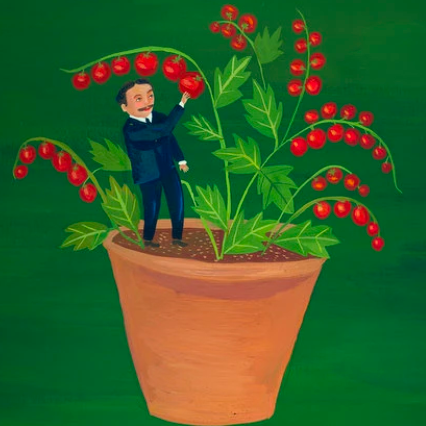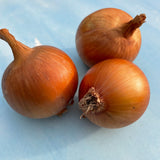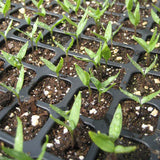
10 Container Gardening Tips and Top Varieties for Small Spaces
A sunny corner, a pot of good soil, and seeds is all you need to grow your own dinner. Here are our best tips for growing a productive container garden.
For landless green-thumbs, hungry urban gardeners, or those whose yards double as deer playgrounds: container gardening is the way to grow. We offer a multitude of varieties that thrive in pots on sunny windowsills and porches. Meet our top picks of petite plants that pack a punch, then read on to learn our best tips for container gardening:
Nearly all the greens in our catalog will grow well in containers, but Metta Lettuce Mix will maximize the salad offerings of a small space. This mix of colors and textures is meant for baby leaf lettuce and lends itself perfectly to multiple cuttings and succession sowing all season long.
2. Organic Blue Jade Dwarf Sweet Corn.
We are smitten with Blue Jade Dwarf Sweet Corn! Not only is this darling dwarf variety small enough for container planting and produces 2-3 ears (about half the size of a standard sweet corn) per plant, but - best of all - it’s the tastiest sweet corn we’ve ever tried.
All culinary herbs we offer will thrive in pots (although some perennials may need to be protected over winter) and the Basil Bouquet is an especially great mix to start your container herb garden. The 5 diverse basils in this seed mix will please all the senses, providing 1) powerful cooking herbs, 2) garden aromatherapy, 3) a feast for the pollinators, 4) and unique, fragrant cutting flowers.
This compact bushy pepper is terrific for containers! Its tiny, spicy fruits in greens, yellows, and reds completely cover the sprawling, low-growing plants, which have deep green, semi-glossy leaves. It only takes one match to light a fire: just one of these little peppers will lend a fruity and flavorful heat to any dish.
When space is limited, these itty bitty bite-size cucumbers offer a vertical solution. With a simple trellis, Mexican Sour Gherkins will grow up as sprawling, small-leaved vines, then fill with unique refreshing fruits that are both sweet and tangy.
Tiny Tim Tomato is happiest in containers. Each petite plant produces copious quantities of cherry-sized sweet-tart-tangy fruits. The tiny one-inch, red tomatoes are ready early and excel in sunny window boxes, picnic table centerpieces, and pots on city stoops.
7. Organic Tokyo Market Turnip.
This sweet, crunchy, fast-growing turnip isn’t afraid of the cold nor the heat. Perfect for fresh snacking and producing harvestable greens in less than a month, this little turnip can be sown all season long. Sprinkle seeds wherever you have a patch of open soil in between other container plantings.
Bred specifically for container culture, these petite peas need no trellis as they don't get taller than a foot before growing tiny, sweet shelling pods.
9. Glorious Gleam Nasturtiums.
Glorious Gleam Nasturtiums make smart use of a small space. They will trail down the side of a container and along the ground, producing beautiful and edible flowers along the way.
10. Organic Teddy Bear Sunflower.
This sunflower is as cute and diminutive as its namesake: it grows plush golden pillow-like blooms at the end of stubby stems no taller than two feet.
10 Container Gardening Tips
Don't limit yourself to the varieties above! Gardening is about experimenting. We've heard from people growing so many unconventional varieties successfully in containers. Here's how:
Spacing:

1. The bigger the plant, the bigger the pot. Choose larger containers for varieties that will grow tall, bushy, or bear heavy fruit.
2. More days to maturity, more room to grow. Crops that take a long time to get ready for harvest (like tomatoes or winter squash) or ones that will be harvested many times in a season (like kale or perennial herbs) need bigger pots.
3. No crowding. You can plant a bit closer than normal when growing in a pot, but overcrowding leads to weak, spindly plants. One tomato plant in a big pot will produce more tomatoes than 4 tomato plants in the same pot.
Watering:
4. Pots are thirsty. They dry out quickly. Try not to let your container garden dry out completely between watering, but don’t water so much that plants are constantly saturated (this can cause rot and mold) - sticking to a watering schedule helps.
5. Have drainage. Many containers come with built-in drainage: holes in the bottom, or a permeable materials (like our Root Pouches).
Location:
6. Container plants need lots of sun too! If you have part-shade, stick to herbs and greens.
7. Rooftops can be windy. If growing in containers on the roof, consider setting up some kind of windbreak, like lattice, that won’t cast shade and place pots close together so they brace against each other.
Soil:
8. Use a light potting mix, but be sure to mix in nutrient rich compost.
9. Fruiting plants (like tomatoes, melons) need more soil and more nutrients than greens and herbs.
Timing:
10. Succession sow. To get the most food out of a limited space, plant seeds in staggered succession. Learn more how to make a succession plan for endless summer salads here. Be sure to add compost and nutrients between sowings to keep the soil healthy and productive.






